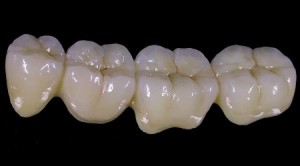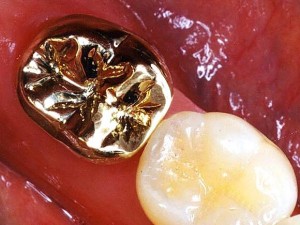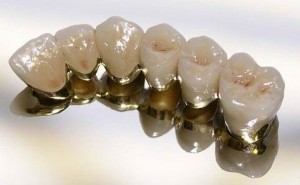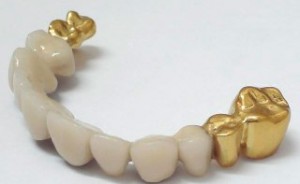Chewing crowns

Chewing teeth perform one of the important functions - participation in the process of chewing food.
In some cases, when the teeth are not treatable or lost, crowns prosthetics may be necessary.
Dental crowns on chewing teeth are able to protect them from further destruction. Moreover, they fully perform their functions.
To restore the chewing teeth, both single tooth crowns and bridges are successfully used.
When installing a bridge, the dental crowns are fixed to the abutment teeth.
Types of crowns
For prosthetics of a chewing group of teeth, constructions made of metal, cermets or ceramics are used.
Metal

- Cast constructions have a metallic color.
- Crowns made of metal are most often installed on the chewing group of teeth with increased enamel abrasion.
- They are distinguished by strength, reliability and durability.
- With high-quality manufacturing, metal cast structures have a long service life, which can reach 10-12 years.
- In addition, for their installation, it is not necessary to sharpen the tooth much than to fix the cermet.
- The cost of crowns, compared with ceramics and cermets, is negligible and is about 3500 rubles.
- The disadvantage of metal crowns is a low level of aesthetics.
Cermets

- The structures consist of a metal frame coated on top with a ceramic mass.
- Such crowns are highly aesthetic and durable. The disadvantage of the designs is that a large volume of bone tissue is polished under their installation.
- The cost of one design is within 6000 rubles for one crown.
Metal free ceramics
Ceramic crowns are the best and most expensive option.
Ceramic-ceramic and ceramic tooth crowns mounted on chewing teeth make them indistinguishable from real teeth.
The peculiarity of all-ceramic crowns is that they are made without a metal base and light penetrates freely through the tooth enamel, which gives them a natural look.
Porcelain constructions are absolutely harmless, as they are made of bioinert material. Usually they are placed on a group of teeth that fall into the line of a smile, but in some cases they chew prosthetics.
Combined Bridge Structures

For prosthetics of the chewing group and teeth that fall into the smile zone, it is possible to install ceramic crowns on the front ones and fix metal structures on the rear ones.
Such an option for prosthetics is acceptable when the patient needs the proper aesthetics, but wants to save a little.
For example, in the manufacture of a bridge from the fifth tooth to the seven. In this case, only those teeth that fall into the smile line can be veneered with ceramics. Thus, when replacing one ceramic crown with a metal one, you can save up to 3 thousand rubles.
Removable dentures
The most common type of prosthesis for chewing teeth is the manufacture of removable structures. They are able to restore aesthetic and chewing function.
Indications for installing removable crowns on chewing teeth:
- Multiple absence of chewing teeth.
- Dental mobility caused by periodontal disease.
- If it is not possible to install implants.
- As a temporary design for the period of manufacture of the permanent crown.
Crown life
The life of a well-made chewing crown is on average from ten to twelve years.
- The duration of use of the crown depends on the quality of preparatory work carried out before fixing the structure.
- Of great importance is the hygienic care of the oral cavity and compliance with the rules of operation of the dental structure.
Which crown to choose
The choice of a crown for prosthetics of chewing teeth depends on some conditions.
- If you have your own tooth, which must be protected with a crown from destruction, you can install a crown made of non-metal ceramics. They have high aesthetics and are quite reliable.
- If the teeth have thin walls that can even break when turning, then cermet will be the best choice. Due to the fact that the design has a metal frame, the entire load during chewing will be exerted on it, which will protect the tooth from further destruction.
- If the patient has enough money and wants to install crowns that will be invisible to others and have high strength, then you can make a choice in favor of ceramics and cermets.
- In the case when the patient is limited in funds and he cannot afford to pay a round sum, then you can stop the choice on metal structures.
Only a dentist can recommend this or that type of crown, but before that it is necessary to put in order those teeth that need treatment.
Also, during the examination, the doctor will determine the degree of strength of the walls of the teeth, whether they can withstand the installation of crowns and will not be destroyed.
Only after this, the dentist will recommend the most optimal type of crown. When choosing the wrong crown, the patient may eventually lose a tooth altogether.